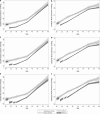The impact of parity on life course blood pressure trajectories: the HUNT study in Norway
- PMID: 29368194
- PMCID: PMC6061132
- DOI: 10.1007/s10654-018-0358-z
The impact of parity on life course blood pressure trajectories: the HUNT study in Norway
Erratum in
-
Correction to: The impact of parity on life course blood pressure trajectories: the HUNT study in Norway.Eur J Epidemiol. 2018 Sep;33(9):895. doi: 10.1007/s10654-018-0412-x. Eur J Epidemiol. 2018. PMID: 29980890 Free PMC article.
Abstract
The drop in blood pressure during pregnancy may persist postpartum, but the impact of pregnancy on blood pressure across the life course is not known. In this study we examined blood pressure trajectories for women in the years preceding and following pregnancy and compared life course trajectories of blood pressure for parous and nulliparous women. We linked information on all women who participated in the population-based, longitudinal HUNT Study, Norway with pregnancy information from the Medical Birth Registry of Norway. A total of 23,438 women were included with up to 3 blood pressure measurements per woman. Blood pressure trajectories were compared using a mixed effects linear spline model. Before first pregnancy, women who later gave birth had similar mean blood pressure to women who never gave birth. Women who delivered experienced a drop after their first birth of - 3.32 mmHg (95% CI, - 3.93, - 2.71) and - 1.98 mmHg (95% CI, - 2.43, - 1.53) in systolic and diastolic blood pressure, respectively. Subsequent pregnancies were associated with smaller reductions. These pregnancy-related reductions in blood pressure led to persistent differences in mean blood pressure, and at age 50, parous women still had lower systolic (- 1.93 mmHg; 95% CI, - 3.33, - 0.53) and diastolic (- 1.36 mmHg; 95% CI, - 2.26, - 0.46) blood pressure compared to nulliparous women. The findings suggest that the first pregnancy and, to a lesser extent, successive pregnancies are associated with lasting and clinically relevant reductions in systolic and diastolic blood pressure.
Keywords: Blood pressure; Epidemiology; Life course; Parity; Pregnancy.
Conflict of interest statement
Conflict of interest
The authors declare that they have no conflict of interest.
Ethical approval
All procedures performed in studies involving human participants were in accordance with the ethical standards of the institutional and/or national research committee and with the 1964 Helsinki declaration and its later amendments or comparable ethical standards.
Informed consent
Informed consent was obtained from all individual participants included in the study.
Figures


References
MeSH terms
Grants and funding
LinkOut - more resources
Full Text Sources
Other Literature Sources

